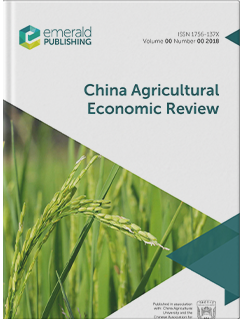Optimization analysis of grain self-production and import structure based on carbon footprint
IF 4.6
2区 经济学
Q1 AGRICULTURAL ECONOMICS & POLICY
引用次数: 2
Abstract
PurposeThe purpose of this paper is to reduce the carbon footprint of food by adjusting the international trade and planting structure and to provide possible ideas for the improvement of the world's food green production and green trade.Design/methodology/approachUsing the literature analysis method to collect carbon footprint data calculated based on the life cycle assessment (LCA) method, and establishing an optimization model and an ARIMA prediction model for empirical analysis, this paper explores the possibility to reduce carbon emissions by adjusting import structure and self-production structure.FindingsThe results show that only through the adjustment of the import structure, carbon emissions can be reduced by 3.29 million tons at the source of imports. When domestic self-production is included, a total of 4.51 million tons of carbon emissions can be reduced, this provides ideas for low-carbon emission reduction in agriculture and animal husbandry.Originality/valueThis article is the first to use the carbon footprint data obtained by other scholars using LCA to optimize and analyze the grain trade structure and planting structure from a low-carbon perspective, and obtain specific emission reductions.基于碳足迹的粮食自产自销结构优化分析
目的通过调整国际贸易和种植结构来减少粮食的碳足迹,为改善世界粮食绿色生产和绿色贸易提供可能的思路。设计/方法论/方法利用文献分析方法收集基于生命周期评估(LCA)方法计算的碳足迹数据,并建立优化模型和ARIMA预测模型进行实证分析,探索通过调整进口结构和自产结构来减少碳排放的可能性。研究结果表明,只有通过调整进口结构,才能在进口源头减少329万吨碳排放。如果算上国内自产,总共可以减少451万吨碳排放,这为农牧业的低碳减排提供了思路。原创/价值本文首次利用其他学者利用LCA获得的碳足迹数据,从低碳角度对粮食贸易结构和种植结构进行优化分析,得出具体的减排量。
本文章由计算机程序翻译,如有差异,请以英文原文为准。
求助全文
约1分钟内获得全文
求助全文
来源期刊

China Agricultural Economic Review
AGRICULTURAL ECONOMICS & POLICY-
CiteScore
9.80
自引率
5.90%
发文量
41
审稿时长
>12 weeks
期刊介绍:
Published in association with China Agricultural University and the Chinese Association for Agricultural Economics, China Agricultural Economic Review publishes academic writings by international scholars, and particularly encourages empirical work that can be replicated and extended by others; and research articles that employ econometric and statistical hypothesis testing, optimization and simulation models. The journal aims to publish research which can be applied to China’s agricultural and rural policy-making process, the development of the agricultural economics discipline and to developing countries hoping to learn from China’s agricultural and rural development.
 求助内容:
求助内容: 应助结果提醒方式:
应助结果提醒方式:


